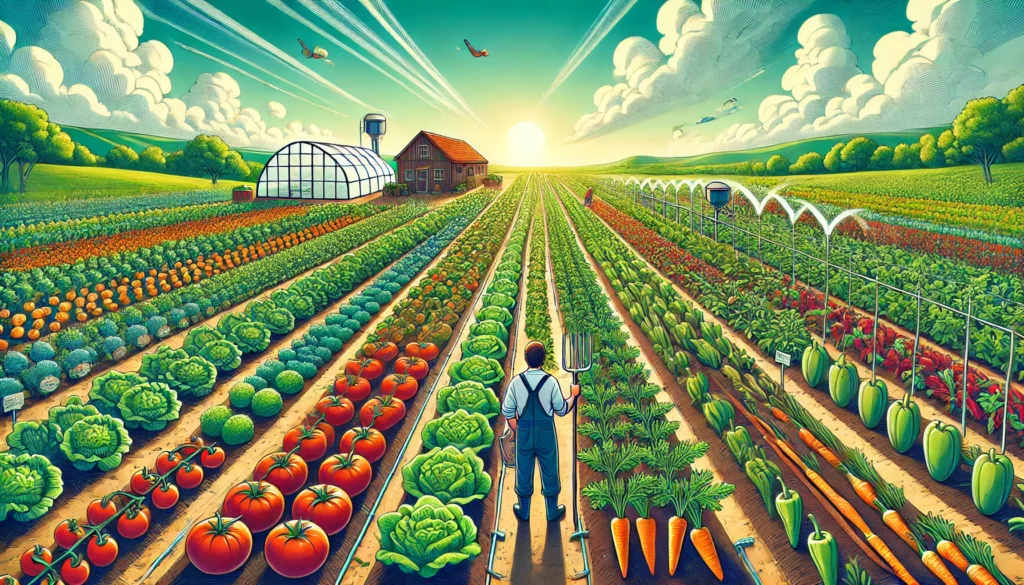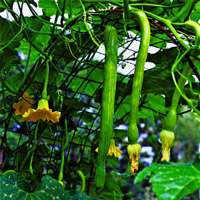10 Unstoppable Strategies for A Vegetable Farm
Vegetable Farm: Cultivating Sustainable Agriculture
Introduction to A Sustainable Vegetable Farm
In today’s rapidly evolving world, the importance of sustainable agriculture cannot be overstated. As global populations rise and environmental concerns grow, sustainable vegetable farming emerges as a beacon of hope for food security and ecological balance.
This article delves into the intricacies of vegetable farming, highlighting techniques, benefits, and strategies for creating a thriving, sustainable farm.

1. Master Soil Health
Healthy soil is the lifeblood of any thriving vegetable farm. Implement crop rotation, cover cropping, and composting to enrich the soil with essential nutrients and improve its structure.
Regularly test the soil to monitor nutrient levels and make necessary adjustments.
2. Optimize Water Management
Efficient water use is crucial for sustainable farming. Implement drip irrigation systems to deliver water directly to plant roots, reducing evaporation and runoff. Harvest rainwater and use mulching techniques to retain soil moisture and reduce water usage.
3. Embrace Integrated Pest Management (IPM)
Adopt IPM strategies to control pests while minimizing chemical use. Encourage natural predators, plant pest-resistant varieties, and use physical barriers to protect crops. Regular monitoring and targeted interventions keep pest populations under control without harming the environment.
4. Implement Polyculture and Companion Planting
Grow a diverse array of crops together to enhance biodiversity and soil health.
Use companion planting to pair mutually beneficial plants, such as planting marigolds with tomatoes to deter pests and improve growth. Polyculture systems mimic natural ecosystems, making them more resilient.
5. Utilize Greenhouses and Controlled Environments
Using greenhouses can extend your growing season and protect crops from adverse weather. Advanced techniques like hydroponics and aeroponics in controlled environments can significantly boost yield and efficiency, allowing year-round production of high-quality vegetables.
6. Select High-Quality Seeds
Invest in high-quality, disease-resistant seeds to ensure robust crops. Save seeds from successful harvests to maintain genetic diversity and reduce dependency on commercial seed suppliers. Heirloom and open-pollinated varieties offer excellent options for sustainable farming.
7. Harness Precision Agriculture
Leverage technology to optimize farm management. Use GPS mapping, drones, and soil sensors to collect real-time data on crop health, soil conditions, and weather patterns. Precision agriculture allows for targeted interventions, maximizing efficiency and yield.
8. Focus on Post-Harvest Handling
Proper post-harvest handling preserves the quality and extends the shelf life of your produce. Sort, clean, and package vegetables carefully, and invest in adequate storage facilities like refrigeration units. Efficient post-harvest practices reduce waste and increase profitability.
9. Explore Value-Added Products
Diversify your income by transforming raw vegetables into value-added products. Create items like pickles, sauces, and dried goods to appeal to consumer demand for convenience and variety. Value-added products can also reduce post-harvest losses.
10. Engage with the Community
Build a strong brand and connect with your local community. Sell directly to consumers through farmers’ markets, CSAs, and online platforms. Partner with local businesses and educate the public about sustainable farming practices to build a loyal customer base and support local food systems.
The Foundations of Vegetable Farming
Understanding Soil Health
Soil health is the cornerstone of any successful vegetable farm. Healthy soil teems with microorganisms, nutrients, and organic matter essential for robust plant growth. Implementing crop rotation, cover cropping, and composting practices can significantly enhance soil fertility and structure.
Crop Rotation and Its Benefits
Crop rotation involves alternating different types of crops in the same area across seasons. This practice helps prevent soil depletion, control pests, and reduce plant disease risk.
For instance, rotating legumes with leafy greens can replenish nitrogen levels in the soil, promoting healthier subsequent crops.
The Role of Organic Matter
Incorporating organic matter, such as compost and manure, into the soil improves its water-holding capacity and nutrient content.
Organic matter also supports a diverse soil ecosystem, fostering beneficial organisms that aid in plant growth and disease resistance.
Vegetable Farm
Water Management Techniques
Efficient water management is crucial for sustainable vegetable farming.
Techniques such as drip irrigation and rainwater harvesting ensure optimal water usage, reducing waste and conserving this precious resource. Mulching can also help retain soil moisture, keeping the roots cool and hydrated.
Integrated Pest Management (IPM)
IPM is a holistic approach to pest control that combines biological, cultural, and mechanical methods. By promoting natural predators, using pest-resistant crop varieties, and employing physical barriers, farmers can minimize the need for chemical pesticides, thus safeguarding the environment and human health.
Polyculture and Companion Planting
Polyculture involves growing multiple crop species in the same space, mimicking natural ecosystems. This method enhances biodiversity, improves soil health, and reduces pest outbreaks.
Companion planting, a form of polyculture, involves pairing plants that benefit each other. For example, basil is planted alongside tomatoes to deter pests and enhance flavor.
Maximizing Yield with Modern Techniques
Greenhouses and Controlled Environments
Greenhouses provide a controlled environment for vegetable farming, allowing for year-round production regardless of external weather conditions.
Advanced technologies, such as hydroponics and aeroponics, further optimize plant growth by providing nutrients directly to the roots in a soil-free medium.
Genetic Selection and Seed Saving
Choosing the right seed varieties is crucial for maximizing yield and ensuring resilience against pests and diseases.
Heirloom and open-pollinated seeds can be saved and replanted, preserving genetic diversity and reducing dependence on commercial seed producers.
Precision Agriculture
Precision agriculture employs technology to monitor and manage farm operations with high accuracy. Tools like GPS mapping, drones, and soil sensors provide real-time data on soil health, crop conditions, and environmental factors, enabling farmers to make informed decisions and optimize resource use.
Sustainable Harvesting and Post-Harvest Practices
Timely and Efficient Harvesting
Harvesting vegetables at the right time maximizes quality and market value. Employing efficient harvesting techniques and equipment can reduce labor costs and minimize crop damage.
Post-Harvest Handling and Storage
Proper post-harvest handling, including sorting, cleaning, and packaging, ensures that vegetables retain their freshness and nutritional value.
Adequate storage facilities, such as cool rooms and refrigeration units, extend the shelf life of produce, reducing food waste and increasing profitability.
Value-Added Products
Transforming raw vegetables into value-added products, such as pickles, sauces, and dried goods, can diversify income streams and reduce post-harvest losses. This approach also caters to consumer demand for convenience and variety.
Marketing and Community Engagement
Building a Brand
Creating a strong brand identity helps distinguish your vegetable farm in the competitive market. This includes developing a compelling story, designing attractive packaging, and maintaining a professional online presence.
Direct-to-Consumer Sales
Selling directly to consumers through farmers’ markets, community-supported agriculture (CSA) programs and online platforms can enhance profit margins and foster customer loyalty. E
ngaging with the community and educating consumers about sustainable farming practices builds trust and support.
Collaborating with Local Businesses
Partnering with local restaurants, grocery stores, and food co-ops can expand your market reach and provide consistent sales channels.
Establishing these relationships can also promote local food systems and reduce the carbon footprint associated with long-distance food transportation.
Challenges and Future Directions
Addressing Climate Change
Climate change poses significant challenges to vegetable farming, including unpredictable weather patterns, increased pest pressures, and water scarcity.
Adapting to these changes through resilient farming practices and innovative technologies is crucial for long-term sustainability.
Promoting Agricultural Education
Education and training programs for farmers, students, and the general public are vital for advancing sustainable agriculture.
Workshops, farm tours, and online courses can disseminate knowledge and inspire the next generation of farmers.
Policy and Advocacy
Advocating for supportive agricultural policies and funding for research and development can create a favorable environment for sustainable vegetable farming.
Engaging in policy discussions and participating in agricultural organizations can amplify the voice of farmers and drive systemic change.
Conclusion
Sustainable vegetable farming is a multifaceted endeavor that requires a deep understanding of ecological principles, innovative techniques, and community engagement.
By prioritizing soil health, implementing efficient water management practices, and embracing modern technologies, farmers can create resilient, productive, and environmentally friendly agricultural systems.
The future of food security and environmental stewardship depends on our collective efforts to promote and practice sustainable farming.





